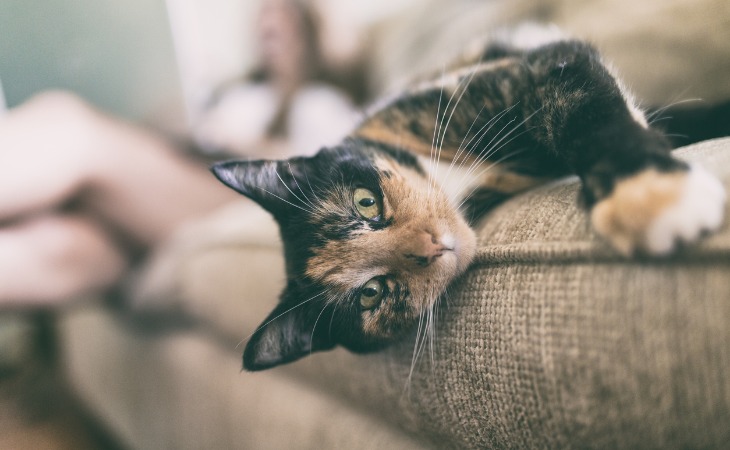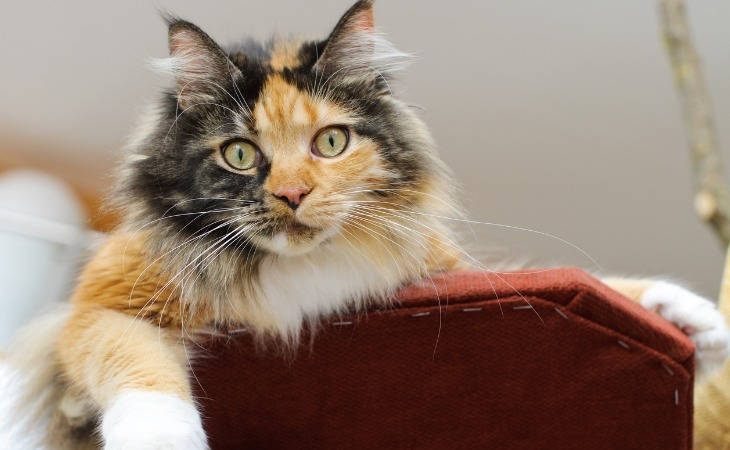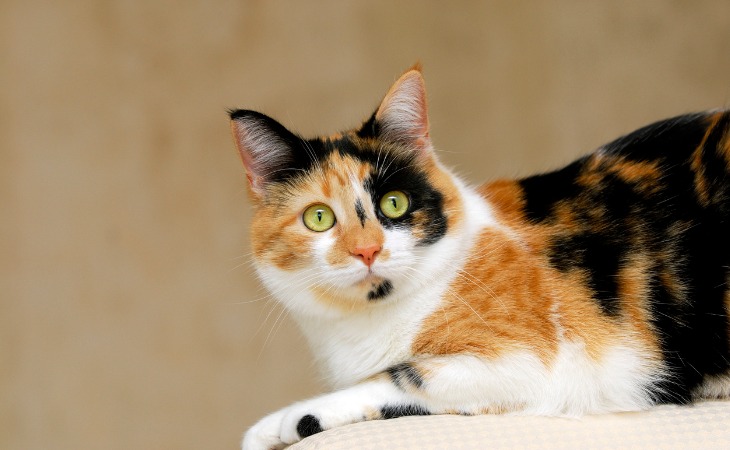Tricolor cats are among the world’s most popular felines. They are also referred to as “calico cats” or “tortoiseshell cats”. Tricolor cats fascinate people with their majestic beauty and are even venerated in some cultures. Many people dream of owning a cat of this sort. Perhaps this is the case for you! Do you know what really makes tricolor cats so special? What are their origins and how does they behave? In this article, we will discover the answers to these questions.
What is a calico, tricolor or tortoiseshell cat?
Contrary to what one might think, calicos do not belong to a specific breed. This name simply designates cats that have a particular coat pattern. A calico can therefore be a Maine Coon, an American Shorthair, an Arabian Mau, a Japanese Bobtail or a Siberian cat.
For a feline to be considered calico, its coat must be made up of three distinct colors (or their variations): black, orange and white.
Each tricolor feline has its own patterns. It’s a bit like fingerprints. It is therefore impossible to find two calico cats with the same pattern. This is true even for those from the same litter.
What are the different types of tricolor cats?
Tricolor cats are split into 3 large families according to the color variations of their coats. There are:
- Calico cats
- Tortoiseshell cats
- Tabby cats
Calico cats are felines with mainly white coats and orange and black (or grey) patches . The white appears predominantly on the belly, chin and chest.
Tortoiseshell cats have a coat with an asymmetrical color mix. They have very little white in their fur and the other colors have much lighter tones compared to those found in standard calicos. Black is generally predominant for tortoiseshell coats.
Tabby cats also have a similar appearance to calico cats. Their coat has a white base with softened spots: gray, light orange, cream or buff.

What are the personality traits of a tricolor cat?
As calicos do not belong to a specific breed, it is very difficult, if not impossible, to say precisely how they typically behave.
However, according to a survey conducted by researchers at the University of California (results published in the Journal of Applied Animal Welfare Science in 2016), there is a link between the color of a cat’s coat and its temperament. According to this study, tricolor cats are rather irritable and temperamental. They are inclined to be aggressive towards humans in certain specific situations:
- during daily interactions
- when carried in someone’s arms
- when taken to the vet
However, these conclusions cannot be generalized, as they are based solely on information provided by a limited number of owners of tricolor cats. These felines are very different from each other and may therefore have completely different character traits.
Remember that their personality depends on several variable factors such as the environment, training, physical fitness, and socialization.
Tricolor, calico or tortoiseshell cats: felines with fascinating genetics
If calico, tabby and tortoiseshell cats are not a cat breed, then where do tricolor felines come from? The answer lies in their DNA. This is because in felines, the color of the coat is closely related to the sex. In other words, the genes responsible for the coloring of a cat’s fur are found in its sex chromosomes (except for the white color gene which is expressed independently).
Just like us, our furry companions have two sex chromosomes: XX for females and XY for males. However, the genetic code that is responsible for the black or orange coloration of their coat is found in the X chromosome. As a general rule, only one of these colors is expressed in cats (in addition to white if the gene carrying it is expressed).
Females can be both colors since they have two X chromosomes. The tricolor cat phenomenon thus occurs when all the color genes are expressed in a cat: the two colors of the X chromosomes in addition to the white color which is independent. It is actually a genetic abnormality that occurs by pure chance. However, because of its nature, it only affects females, or almost only females.
Male tricolor cats are generally sterile
Males with a tricolor coat are carriers of another extremely rare chromosomal abnormality. Instead of having two sex chromosomes (XY), they have three (XXY). This is called Klinefelter’s syndrome. Since there are two X chromosomes, all the colors they carry can be expressed.
In general, animals with Klinefelter’s syndrome have serious health problems that hinder their growth. They are often sterile.
It is impossible to intentionally breed calico cats
The chromosomal abnormality that results in a tricolor cat is not transmissible. In other words, the kittens of a tricolor cat will not systematically inherit the appearance of their parents. In order to be tricolored, they must themselves be carriers of the genetic anomaly.
For this reason, it is impossible to intentionally raise a family of tricolor cats. Even if one crosses two calicos, the appearance of their kittens simply cannot be predicted.

Fun facts about Tricolor cats
What makes tricolor cats special is the mystery that surrounds them. Here are a few unusual facts about these unique felines.
Calico cats represent a state
The calico cat is one of the symbols of the state of Maryland in the United States. It was given this status on October 1, 2001 because of its tricolor fur (orange, black and white), which is reminiscent of the seal of Maryland.
The calico cat is considered a good-luck charm
Calicos are venerated in many countries of the world. For example, in Japan, they are considered lucky charms. In this culture, having a calico type feline at home brings luck, happiness and prosperity. Its presence is also said to be a protection against evil spirits. Thus, every September 29th, this pet is celebrated in Japan.
In Ireland as well, the calico is seen as a mythical animal. According to Irish folklore, they have the ability to cure warts with their tails.
Tricolor cats at a glance
These cats do not come from or belong to a specific breed. Their tricolor coat is due to a genetic mutation that is most often observed in females. Because of this, it is almost impossible to mention any character traits specific to these felines.

